Table of Contents
- Introduction
- Editor’s Choice
- History of Trampoline Sports Statistics
- Trampoline Market Statistics
- Trampoline Park Market Overview
- Trampoline Parks Statistics
- Gymnastics and Trampolining Participation Trends
- Children’s Trampoline Participation Trends and Statistics
- Olympic Trampoline Results Statistics
- Trampoline Gymnastics Rankings 2023 Statistics
- Demographics of Trampoline Participants Statistics
- Demand for Indoor Trampolining
- Trampoline Injuries Statistics
- Trampoline Participation Regulations
- Trampoline Initiatives Statistics
- Recent Developments
- Conclusion
- FAQs
Introduction
Trampoline Statistics: Trampolining is a popular recreational activity and competitive sport that involves bouncing on a flexible surface.
It includes various equipment types, such as recreational trampolines for backyard fun. Gymnastics trampolines for competitions, and mini trampolines for exercise.
Safety is paramount, and measures like safety pads, net enclosures, and adult supervision are recommended.
Basic techniques include vertical jumps, tuck jumps, and seat drops, progressing to advanced maneuvers like flips and twists.
Engaging in trampolining provides numerous health benefits, enhancing cardiovascular fitness, strength, and coordination while also offering enjoyment and stress relief.
As an Olympic sport, trampolining allows participants to progress through skill levels, showcasing their proficiency in routines and techniques.
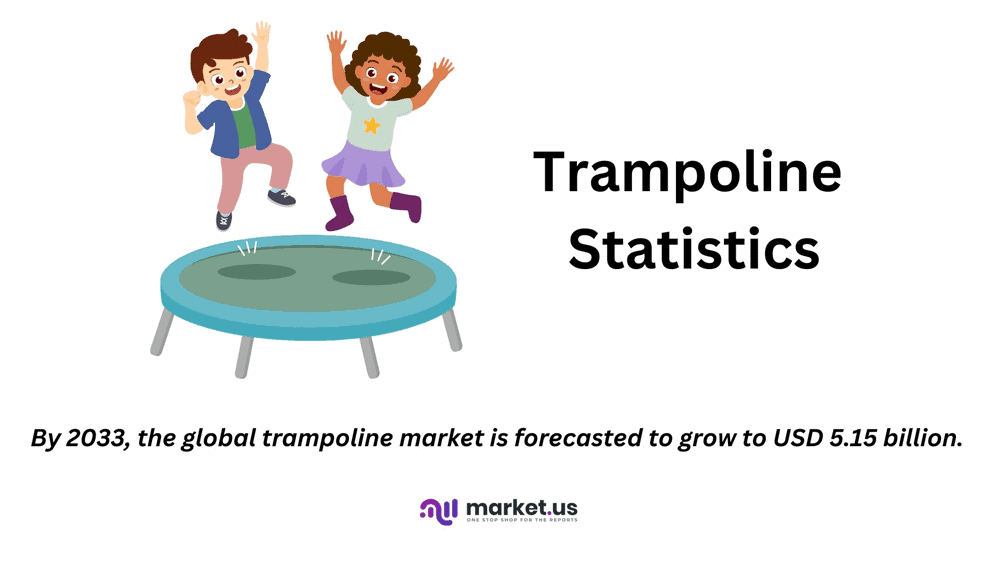
Editor’s Choice
- In 2000, trampolining made its Olympic debut at the Sydney Games, cementing its status as a global sport.
- By 2033, the global trampoline market is forecasted to grow to USD 5.15 billion.
- In 2033, the global trampoline park market revenue is expected to reach USD 3,491.5 million.
- In 2018, the distribution of trampoline parks in the Netherlands by chain demonstrated a varied landscape. JumpXL emerged as the leading chain, holding a 30% share of all trampoline parks. Indicating its dominant position in the market.
- The 2023 Trampoline Gymnastics Men’s rankings feature a diverse group of athletes from around the world. Leading the rankings is WANG Zisai from China, with a total of 230 points.
- During a three-month analysis from April to June 2019 across fifty trampoline parks. Data revealed distinct patterns in the demographics of participants. The most common age for jumpers was found to be nine years old.
- Every year, nearly 100,000 trampoline injuries happen in the United States, leading to about 3,000 hospital stays.
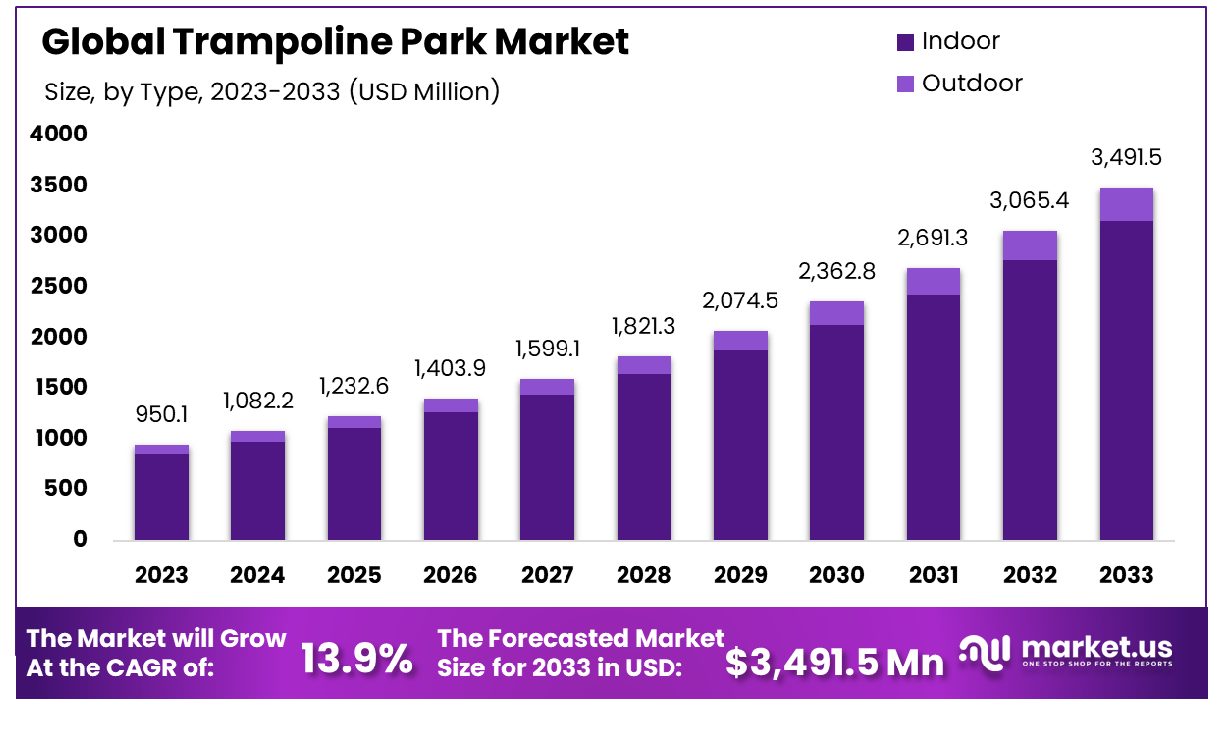
History of Trampoline Sports Statistics
- The history of trampoline sports can be traced back to the 1930s when George Nissen and Larry Griswold, both gymnasts, invented the first modern trampoline in 1936.
- Inspired by trapeze artists, they used a canvas sheet and springs to create a device that would help gymnasts and acrobats practice aerial movements.
- Initially used for training purposes, trampolines gained popularity in the 1950s, with the sport formally recognized in international competitions by 1964, when the first World Championships were held.
- By 2000, trampolining made its Olympic debut at the Sydney Games, cementing its status as a global sport.
- Over the decades, trampolines have evolved in both recreational and competitive settings, with trampoline parks becoming widespread, offering various activities beyond the traditional sport.
- Today, the sport continues to grow, driven by advancements in equipment safety and the increasing visibility of athletes in major competitions.
(Sources: Back Then History, InGroundTampolines)
Take advantage of our unbeatable offer - buy now!

Trampoline Market Statistics
Global Trampoline Market Size Statistics
- The global trampoline market size has experienced steady growth from 2017 to 2033 at a CAGR of 4.62%.
- In 2017, the market was valued at USD 2.50 billion, and by 2018, it had risen to USD 2.62 billion.
- This upward trend continued, with the market size reaching USD 2.74 billion in 2019 and USD 2.86 billion in 2020.
- In 2021, the trampoline market achieved a value of USD 3.00 billion. Which further expanded to USD 3.13 billion in 2022 and USD 3.28 billion in 2023.
- The growth trajectory is projected to persist, with market size estimates reaching USD 3.43 billion in 2024, USD 3.59 billion in 2025, and USD 3.75 billion in 2026.
- By 2027, the market is expected to grow to USD 3.93 billion and further increase to USD 4.11 billion in 2028.
- Projections for 2029 and 2030 show the market size reaching USD 4.30 billion and USD 4.50 billion, respectively.
- This expansion is anticipated to continue through 2031, with a market size of USD 4.70 billion, and by 2032, it is expected to reach USD 4.92 billion.
- By 2033, the global trampoline market is forecasted to grow to USD 5.15 billion.
(Source: market.us)
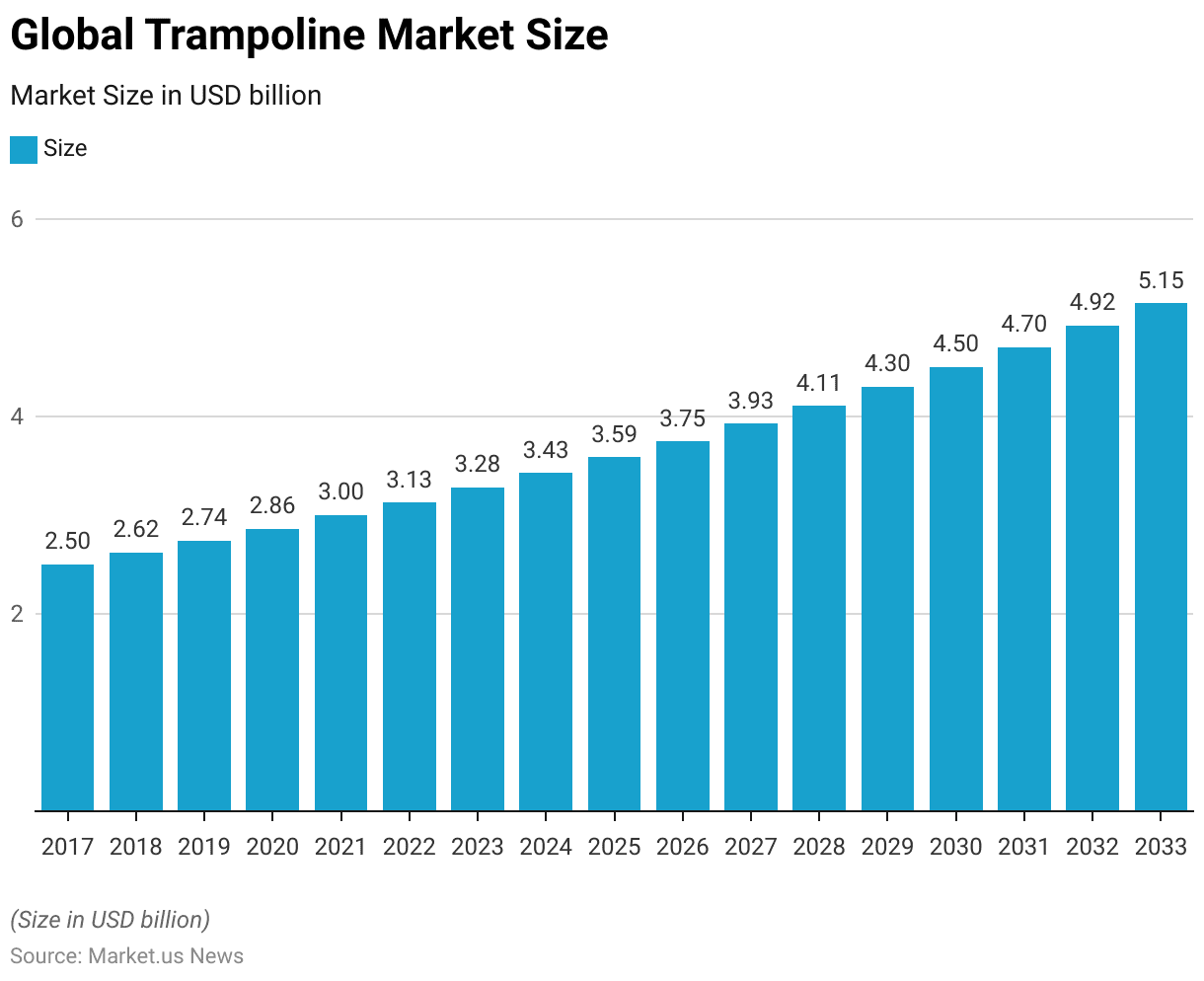
Trampoline Park Market Overview
Global Trampoline Park Market Size Statistics
- The global trampoline park market size is projected to experience significant growth from 2023 to 2033 at a CAGR of 13.90%.
- In 2023, the market was valued at USD 950.1 million.
- By 2024, it is forecasted to increase to USD 1,082.2 million. Followed by further growth to USD 1,232.6 million in 2025.
- The market is expected to continue its upward trajectory. Reaching USD 1,403.9 million in 2026 and USD 1,599.1 million in 2027.
- A continued expansion is anticipated, with the market size reaching USD 1,821.3 million in 2028 and USD 2,074.5 million in 2029.
- As we move into the next decade, projections show the market size increasing to USD 2,362.8 million in 2030, USD 2,691.3 million in 2031, and USD 3,065.4 million in 2032.
- By the end of the forecast period in 2033, the global trampoline park market is expected to reach USD 3,491.5 million.
- This sustained growth underscores the increasing popularity and investment in trampoline parks worldwide.
(Source: market.us)
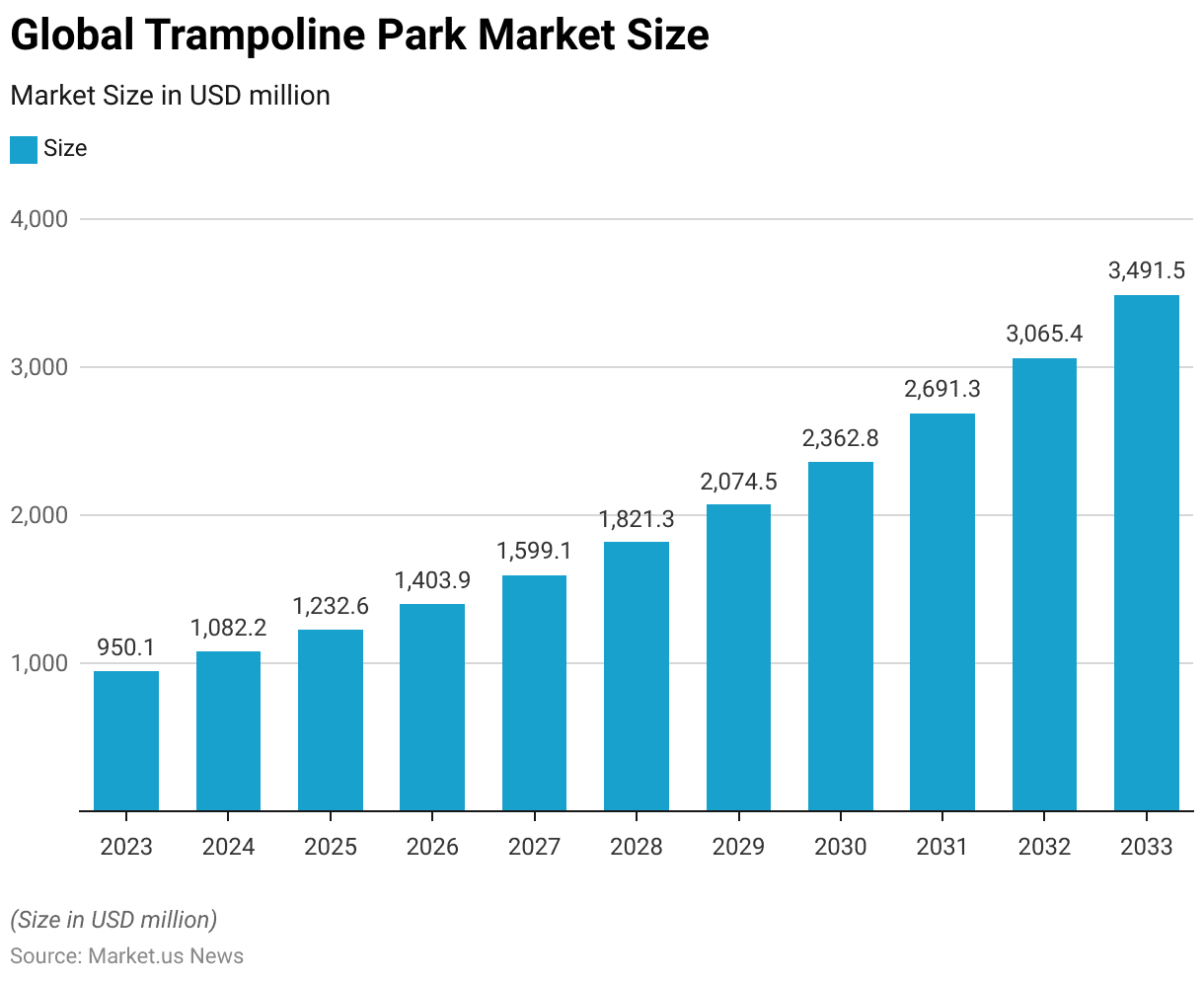
Global Trampoline Park Market Size – By Type Statistics
2023-2027
- The global trampoline park market is segmented into indoor and outdoor types, showing distinct growth patterns from 2023 to 2027.
- In 2023, the total market size stood at USD 950.1 million, with indoor parks accounting for USD 858.89 million and outdoor parks at USD 91.21 million.
- This trend of indoor facilities dominance continues throughout the forecast period.
- By 2024, the market size will grow to USD 1,082.2 million (indoor: USD 978.31 million, outdoor: USD 103.89 million), and by 2025. It will reach USD 1,232.6 million (indoor: USD 1,114.27 million, outdoor: USD 118.33 million).
- In 2026, the total market is valued at USD 1,403.9 million, with indoor parks making up USD 1,269.13 million and outdoor parks USD 134.77 million.
- By 2027, the market will grow further to USD 1,599.1 million (indoor: USD 1,445.59 million, outdoor: USD 153.51 million).
2028-2033
- Continued expansion is evident as the market size reaches USD 1,821.3 million in 2028 (indoor: USD 1,646.46 million, outdoor: USD 174.84 million), USD 2,074.5 million in 2029 (indoor: USD 1,875.35 million, outdoor: USD 199.15 million), and USD 2,362.8 million in 2030 (indoor: USD 2,135.97 million, outdoor: USD 226.83 million).
- The growth pattern persists, with the market size expanding to USD 2,691.3 million in 2031 (indoor: USD 2,432.94 million, outdoor: USD 258.36 million), USD 3,065.4 million in 2032 (indoor: USD 2,771.12 million, outdoor: USD 294.28 million), and finally USD 3,491.5 million in 2033 (indoor: USD 3,156.32 million, outdoor: USD 335.18 million).
- This consistent growth underscores a robust increase in both indoor and outdoor trampoline park investments globally.
(Source: market.us)

Global Trampoline Park Market Share – By End-User Statistics
- In the global trampoline park market, the distribution of market share by end-users reveals a significant preference among adults over children.
- Adults constitute the majority of the market share. Accounting for 60.60%. Indicating a strong adult interest and participation in trampoline park activities.
- Conversely, children, while still representing a substantial portion, hold a smaller share at 39.40%.
- This data underscores the diverse appeal of trampoline parks, attracting a wide range of age groups, with a notably higher participation rate among adults compared to children.
(Source: market.us)
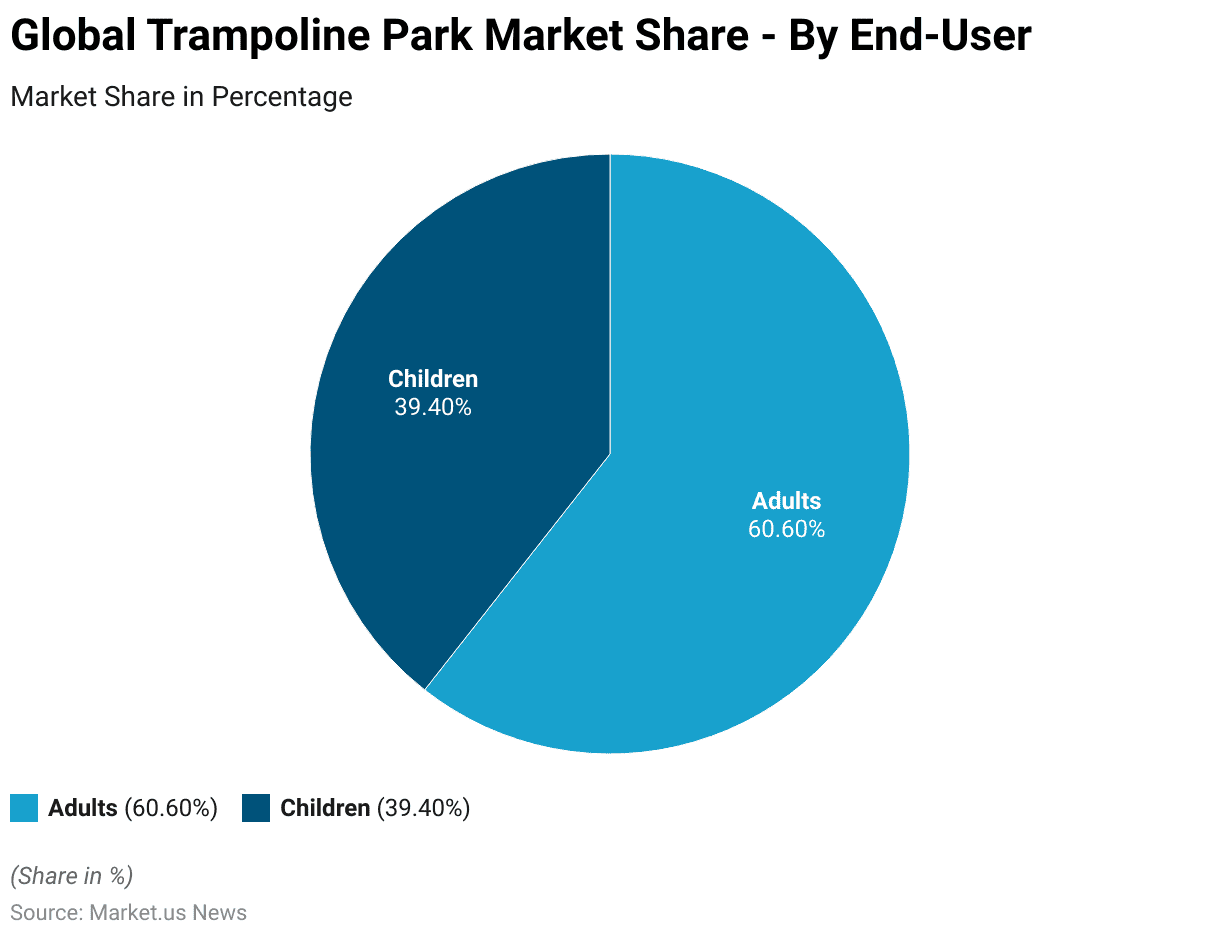
Trampoline Parks Statistics
Distribution of Trampoline Parks – By Chain Statistics
- In 2018, the distribution of trampoline parks in the Netherlands by chain demonstrated a varied landscape.
- JumpXL emerged as the leading chain, holding a 30% share of all trampoline parks. Indicating its dominant position in the market.
- Bounz and Jumpsquare held smaller portions, with 13% and 11%, respectively, highlighting their significant but lesser presence compared to JumpXL.
- The market also featured a considerable number of parks categorized under “Other” and “No chain,” each accounting for 23% of the total.
- This indicates a healthy mix of franchised and independent operations within the Dutch trampoline park industry.
(Source: Statista)
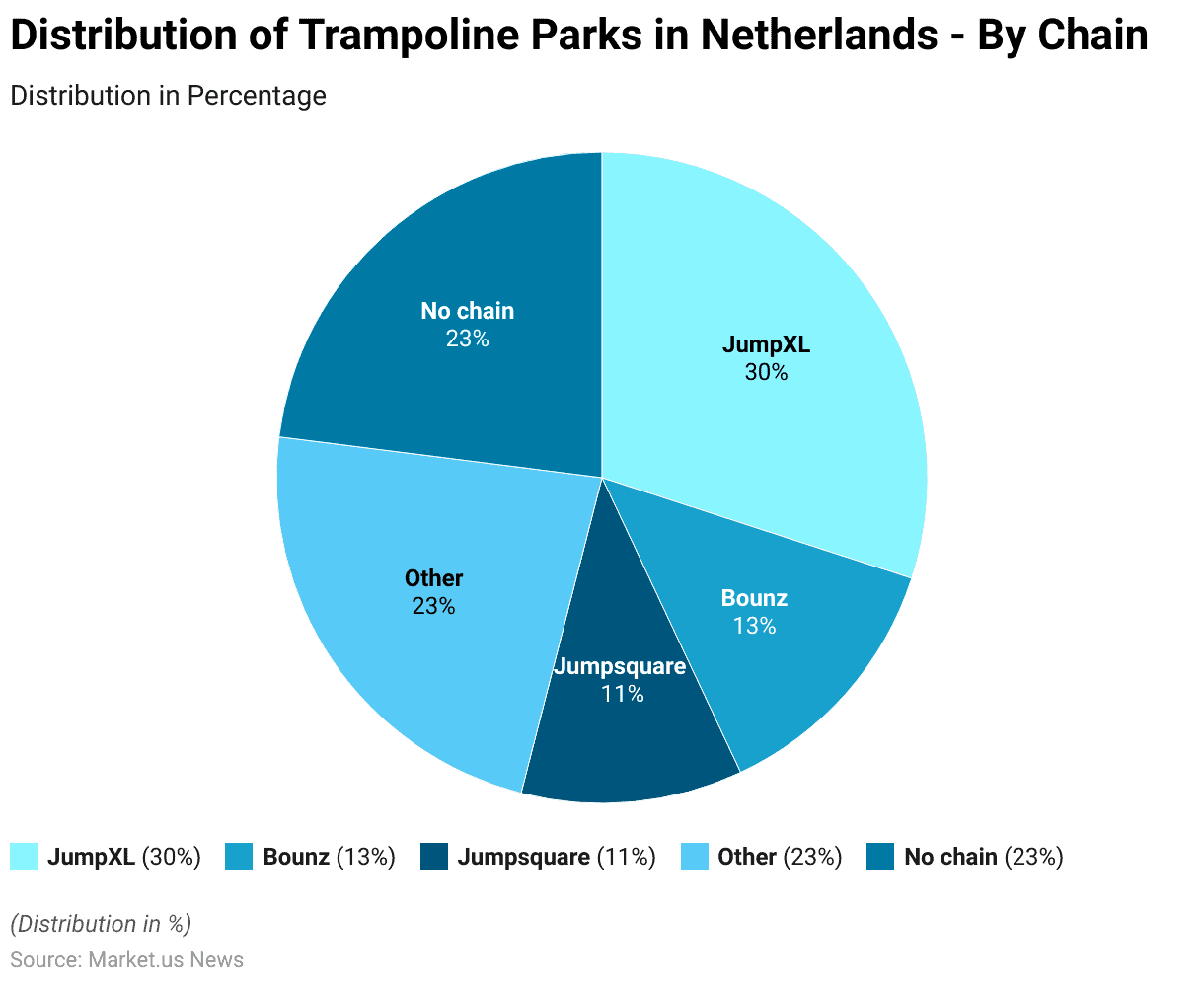
Indoor Trampoline Parks Statistics
- The number of indoor trampoline parks in the Netherlands has shown significant growth from 2011 to 2019.
- Starting with just one park in 2011, the count remained the same in 2012.
- A modest increase was seen in 2013, with the number rising to three parks.
- This growth accelerated in subsequent years, with the number of parks reaching 11 by 2014 and further expanding to 20 by 2015.
- The growth trend continued, with the number of parks increasing to 32 in 2016 and then to 48 in 2017.
- By 2018, the number of indoor trampoline parks had reached 64.
- The forecast for 2019 predicted a substantial rise, with the number of parks expected to jump to 98. Indicating a robust expansion of the trampoline park industry in the Netherlands over this period.
(Source: Statista)
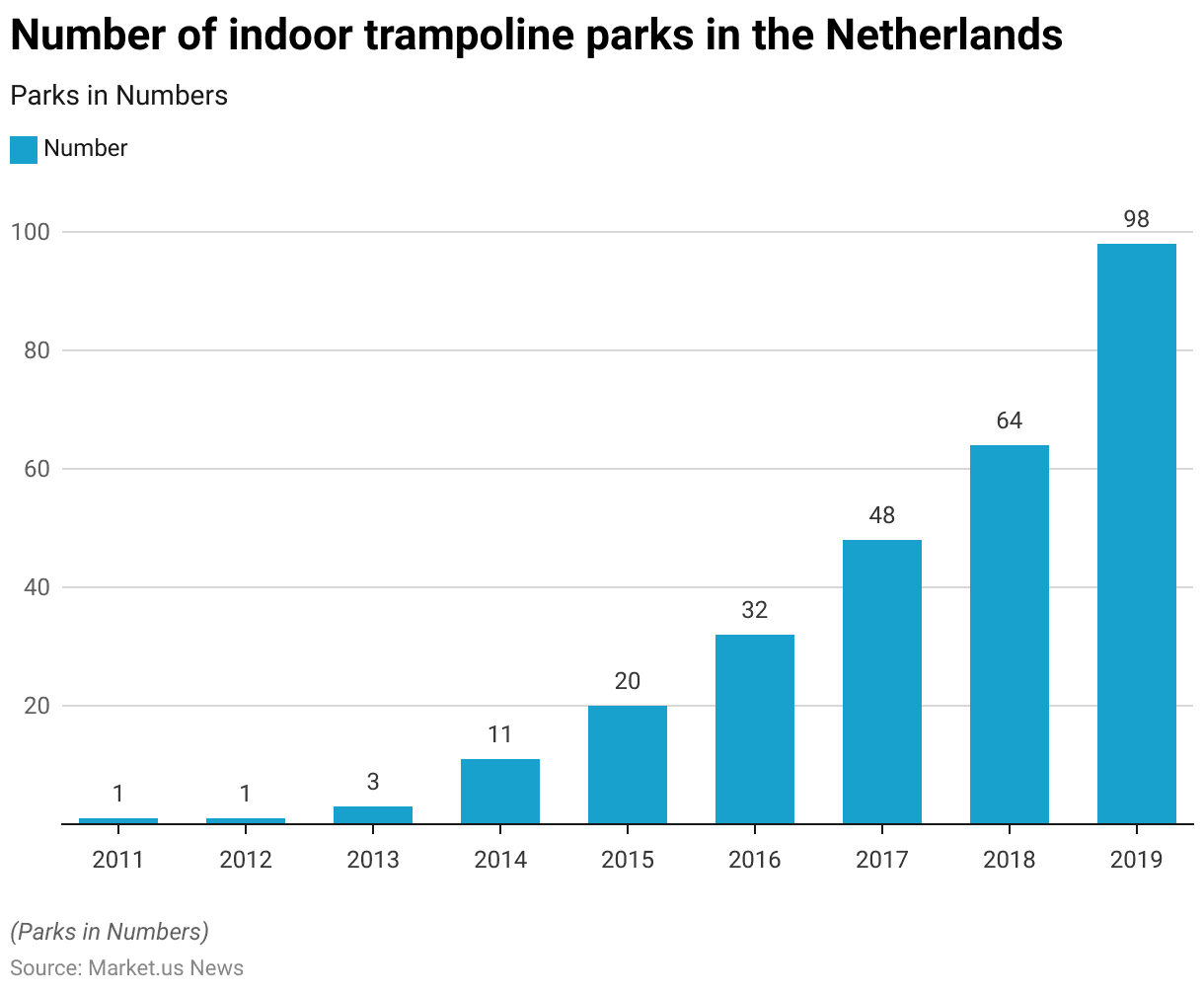
Gymnastics and Trampolining Participation Trends
- From 2016 to 2021, the number of people participating in gymnastics and trampolining in England showed a varied trend.
- In 2016, there were 269,700 participants in these activities.
- This number increased significantly in 2017, reaching a peak of 315,200 participants, indicating growing interest in these sports.
- However, the following years saw a gradual decline, with 283,500 participants in 2018 and 251,200 in 2019.
- The decline became more pronounced in 2020 when the number dropped to 232,600. Likely impacted by external factors such as public health restrictions.
- This downward trend continued sharply into 2021, with the number of participants halving approximately to 110,200. Which may reflect ongoing challenges such as pandemic-related restrictions and changes in public behavior towards indoor recreational activities.
(Source: Statista)
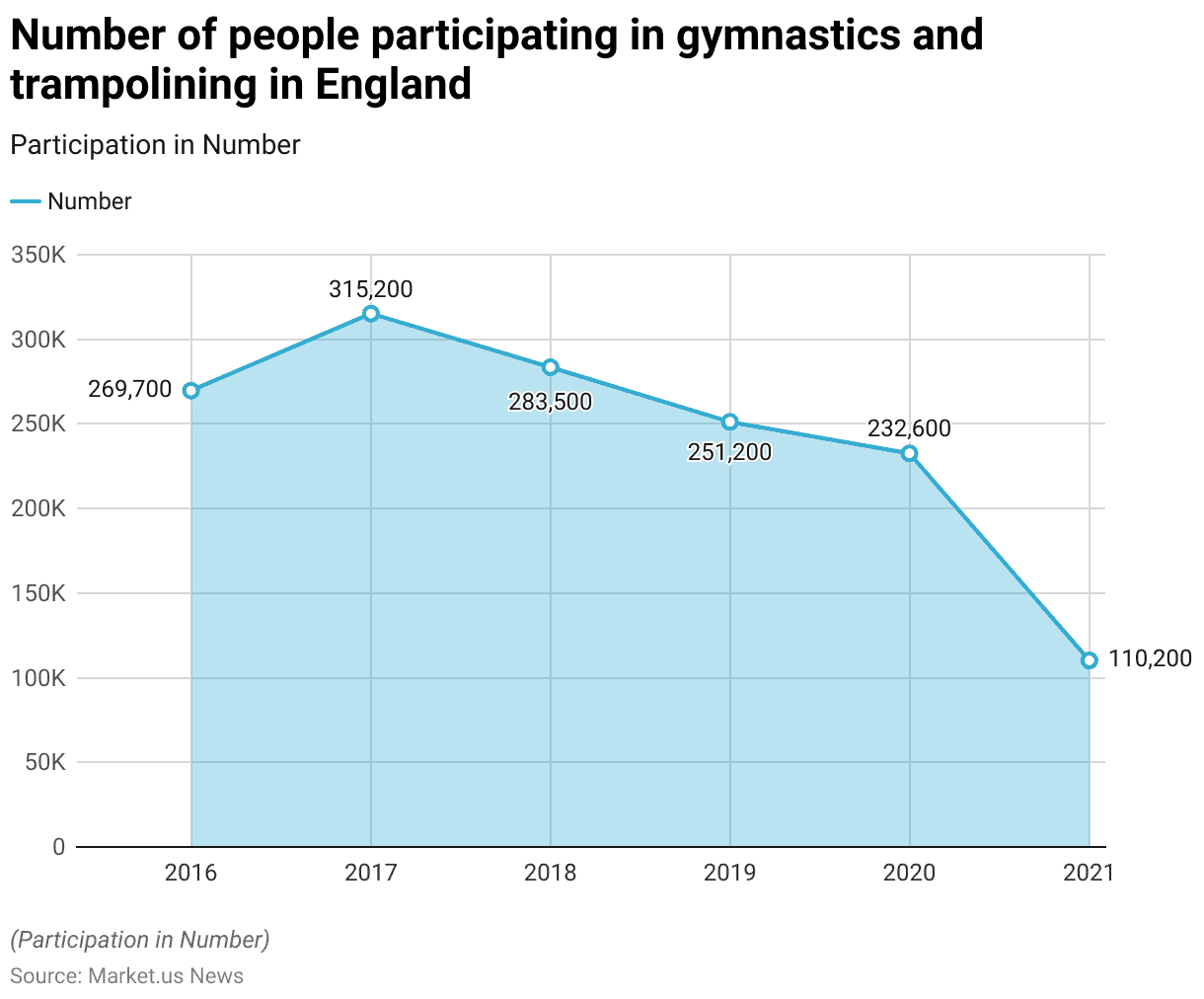
Children’s Trampoline Participation Trends and Statistics
- From 2010 to 2018, the participation of children aged 5-10 and 11-15 in gym, gymnastics, trampolining, or climbing frames in England showed varying trends.
- For children aged 5-10, participation started at 15.20% in 2010-11, dropped to 13% in 2011-12, and reached its lowest at 11.40% in 2012-13.
- However, it began to increase again, rising to 19.80% by 2017-18.
- In contrast, participation rates for children aged 11-15 remained relatively stable, beginning at 24.80% in 2010-11 and fluctuating slightly before peaking at 30.40% in 2016-17.
- By 2017-18, participation in this older age group dropped to 24.40%, similar to the starting levels in 2010-11.
- Overall, both age groups showed some fluctuations, with a general increase over the years, particularly among younger children.
(Source: Statista)
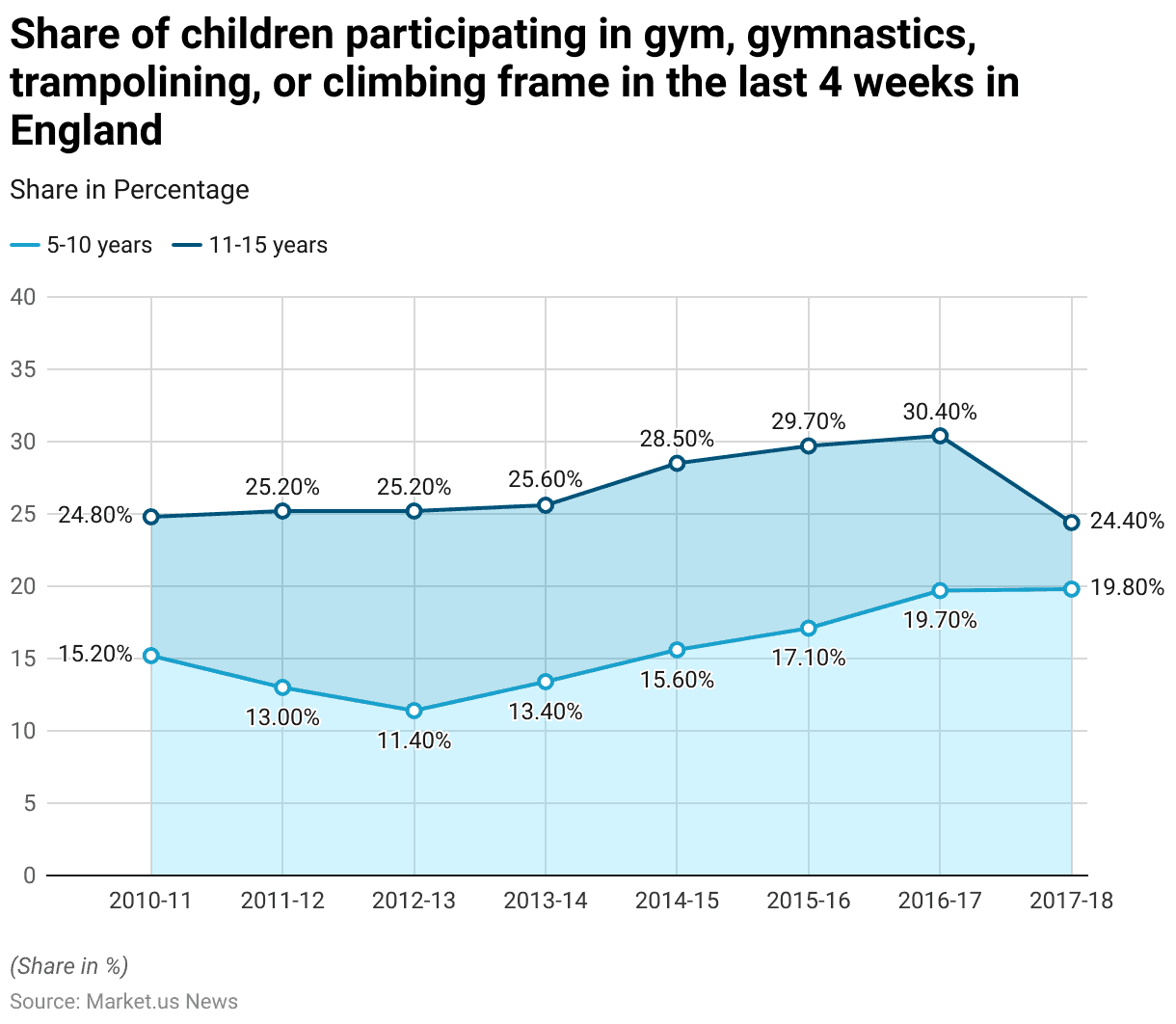
Olympic Trampoline Results Statistics
Sydney 2000
- Trampoline was added to the Olympic program in the late 1990s, prompting Alexander Moskalenko, a three-time world trampoline champion from Russia, to end his retirement.
- He triumphed at the Sydney 2000 Olympics, claiming the gold medal at the age of 30, alongside his fellow Russian and practice partner Irina Karavayeva, who also won gold, making them the first Olympic champions in trampoline.
- Meanwhile, Canada also had a successful outing, with Karen Cockburn from Toronto winning a bronze in the women’s event at just 19 years old.
- Similarly, her then-boyfriend (now husband) Mathieu Turgeon earned a bronze in the men’s event, marking a significant progression from his 15th-place finish at the 1999 World Championships, which had just secured his qualification for the Sydney Games.
- His achievement highlighted a notable and swift advancement in his skill level.
(Source: NBC Olympics)
Athens 2004
- During the Olympics’ second showcase of the trampoline, Ukraine’s Yuri Nikitin unexpectedly won the gold medal, edging out the 2000 Olympic and reigning world champion, Alexander Moskalenko of Russia, by three-tenths of a point.
- Before this Olympic victory, Nikitin had not secured any world championship medals and had only achieved the highest placement of fifth in his four World Championship appearances.
- In the women’s trampoline, Irina Karavayeva of Russia, the previous Olympic champion, did not advance to the final round.
- This allowed Germany’s Anna Dogonadze and Canada’s Karen Cockburn to secure the gold and silver medals, respectively.
- Huang Shanshan from China, who was the youngest competitor at 18, took home the bronze, marking the first time an Asian athlete won an Olympic trampoline medal. Notably, all three medalists scored above Karavayeva’s earlier Olympic score of 38.90.
(Source: NBC Olympics)
Beijing 2008
- At their home Olympics, China secured its first trampoline gold medals with victories in both men’s and women’s competitions.
- In the women’s event, Germany’s Anna Dogonadze, the 2004 Olympic champion, had a fall during the finals and ended up eighth, while 19-year-old He Wenna from China took gold.
- Karen Cockburn of Canada claimed silver, marking her third Olympic medal, and Ekaterina Khilko of Uzbekistan came in third.
- On the following day, in the men’s competition, China’s Lu Chunlong narrowly defeated Jason Burnett from Canada to win gold.
- Another Chinese competitor, Dong, who was relatively new to the international scene, captured the bronze.
- Yuri Nikitin from Ukraine, the 2004 Olympic champion, finished 5th.
- Germany’s Henrik Stehlik, the bronze medalist from Athens, was disqualified during the qualification round due to a judge’s error that was later shown in video replays to be incorrect; however, his protest was denied as replays are not permitted in official reviews.
(Source: NBC Olympics)
London 2012
- In London, neither of the trampoline defending champions from Beijing managed to secure a second gold medal.
- He Wenna from China, the reigning women’s champion, fell to her knees at the conclusion of her routine, ultimately taking the bronze medal.
- Meanwhile, Canada’s Rosie MacLennan achieved a personal best score of 57.305, winning gold and securing Canada’s first Olympic gold medal in the London Games.
- This event also marked a milestone for Team USA, as Savannah Vinsant became the first American to reach the trampoline final since its introduction in the 2000 Olympics.
- On the men’s side, the 2008 gold medalist, China’s Lu Chunlong, was outperformed by his compatriot Dong, who led from the qualifiers and ended the competition more than a point ahead of Russian silver medalist Dmitry Ushakov.
- In a disappointing turn for the U.S., Steven Gluckstein came last in the qualifying round after landing on the safety pads and failing to complete his routine.
(Source: NBC Olympics)
Rio 2016
- In the men’s trampoline competition, China secured both the silver and bronze medals.
- Dong, the gold medalist from 2012, was surpassed by Uladzislau Hancharou of Belarus, who scored 61.745 in his first Olympic appearance to take the gold.
- For the women, Canada’s Rosie MacLennan, at 25 years old, successfully retained her Olympic gold with a score of 56.465.
- She outperformed Bryony Page from Great Britain and Li Dan from China, who was the current world champion at the time.
(Source: NBC Olympics)
Tokyo 2020
- Rosie MacLennan, a two-time Olympic champion, was a favorite to win again following her successes in London and Rio.
- However, Zhu Xueying from China topped MacLennan with a score of 56.635, taking the gold and ending MacLennan’s dominant streak.
- Liu Lingling, also from China, finished close behind Zhu to secure the silver, marking another occasion where two Chinese gymnasts stood on the podium for this event.
- Bryony Page from Great Britain added a bronze medal to her collection with a score of 55.735, following her silver medal in Rio.
- Representing the USA, Nicole Ahsinger matched the country’s best-ever finish in women’s trampoline by placing sixth, equaling the result achieved by Savannah Vinsant in 2012.
- In the men’s competition, Belarus continued its success streak, with Ivan Litvinovich winning gold in Tokyo. At 20 years old and presenting the most challenging routine of the finalists, Litvinovich managed his performance expertly to defeat China’s Dong narrowly.
- Dylan Schmidt from New Zealand earned a score of 60.675, securing third place and winning his nation’s first Olympic medal in any gymnastics event.
(Source: NBC Olympics)
Paris 2024
- In the men’s trampoline final at the Paris Olympics, Belarus’s Ivan Litvinovich, competing as an Individual Neutral Athlete, retained his all-around title from the Tokyo Games, becoming the first male trampolinist to win two Olympic golds.
- China performed well, with Wang Zisai securing second place due to his high execution score and Yan Langyu taking bronze. However, American Aliaksei Shostak fell during qualifications and failed to reach the finals again.
- In the women’s event, Great Britain’s Bryony Page won gold, completing her collection of Olympic medals at age 33.
- Belarus’s Viyaleta Bardzilouskaya, another AIN, earned her first Olympic silver, while Canada’s Sophiane Methot took bronze after narrowly making the finals.
- Defending champion Zhu Xueying of China placed fourth, slightly off-center in her routine, marking the first Olympic trampoline podium without a Chinese athlete since 2000.
- American Jessica Stevens, despite historical success at the 2023 World Championships, did not advance past the qualifications, finishing 13th.
(Source: NBC Olympics)
Trampoline Gymnastics Rankings 2023 Statistics
Mens Individual
- The 2023 Trampoline Gymnastics Men’s rankings feature a diverse group of athletes from around the world.
- Leading the rankings is WANG Zisai from China with a total of 230 points, followed closely by his compatriot YAN Langyu with 197 points.
- New Zealand’s Dylan Schmidt ranks third with 155 points.
- Other notable gymnasts include Danil Mussabayev from Kazakhstan in fourth place with 121 points and Allan Morante from France in fifth with 117 points.
- Ryusei Nishioka from Japan holds the sixth spot with 115 points, just ahead of Diogo Abreu from Portugal with 109 points.
- Austria’s Benny Wizani and Andrew Stamp from Great Britain are closely matched at 108 and 107 points, respectively, rounding out the top ten.
- The rankings continue with several athletes from Portugal, including Gabriel Albuquerque and Pedro Ferreira, as well as competitors from Spain, Brazil, Ukraine, and additional representatives from Japan and France.
- These rankings reflect a competitive field with strong performances across various nations in the sport of trampoline gymnastics.
(Source: Gymnastics)
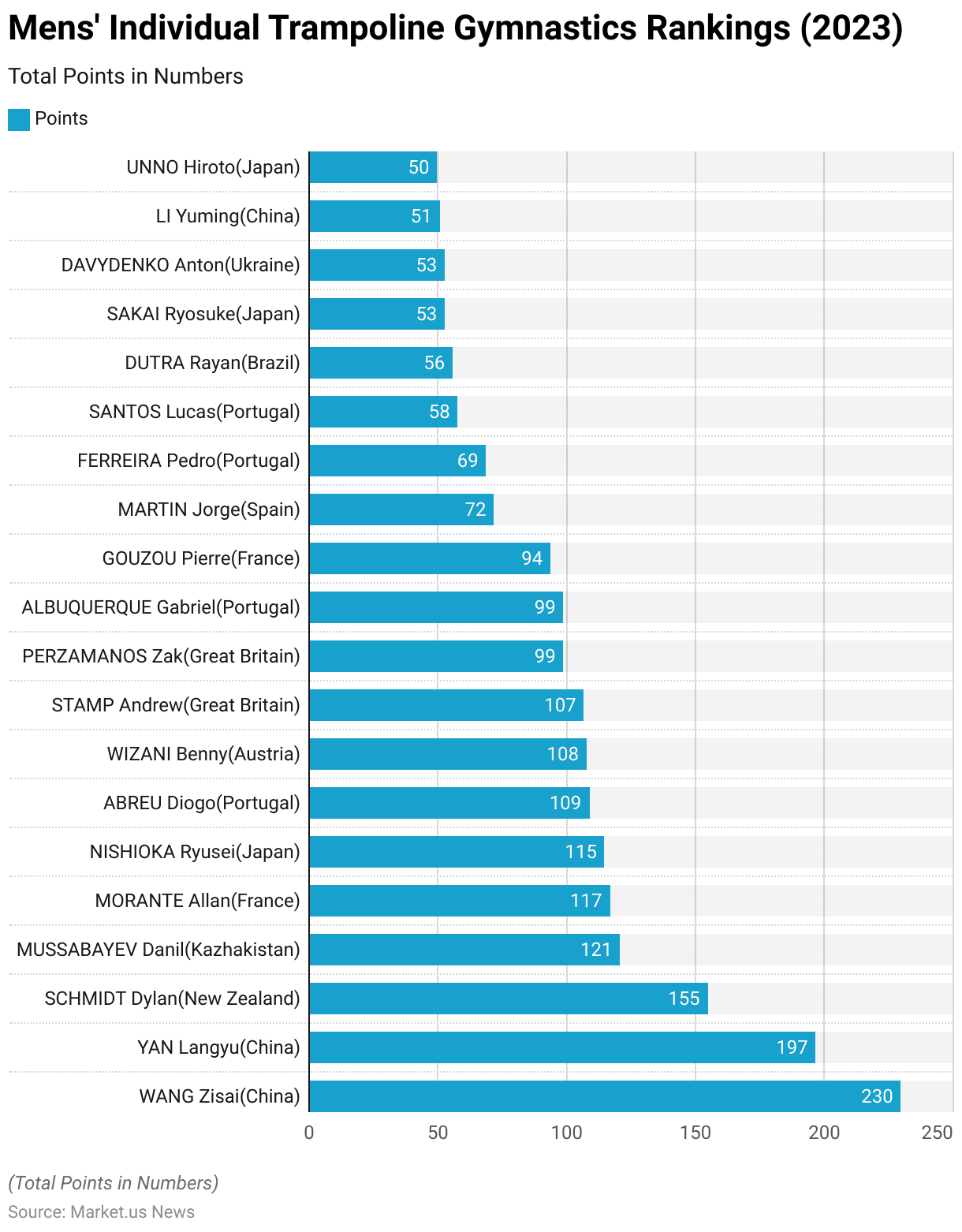
Womens Individual
- ZHU Xueying leads the 2023 Trampoline Gymnastics Women’s rankings from China with a total of 225 points.
- Close behind, Camilla Gomes from Brazil holds the second spot with 193 points, followed by another Chinese gymnast, HU Yicheng, with 187 points.
- Lea Labrousse from France is in fourth place with 157 points, and Bryony Page from Great Britain rounds out the top five with 136 points.
- The rankings continue with Jessica Stevens from the USA in sixth place, accumulating 116 points, and Sophiane Methot from Canada just behind at 113 points.
- Hikaru Mori from Japan is eighth with 112 points, while Fan Xinyi from China is ninth with 98 points.
- The top ten concludes with Seljan Mahsudova from Azerbaijan, holding 89 points.
- Other athletes in the rankings include Alice Gomes from Brazil, Sarah Milette from Canada, and Reina Satake from Japan, alongside competitors from Georgia, New Zealand, Australia, and Spain.
- This diverse group showcases the global talent in women’s trampoline gymnastics this year.
(Source: Gymnastics)
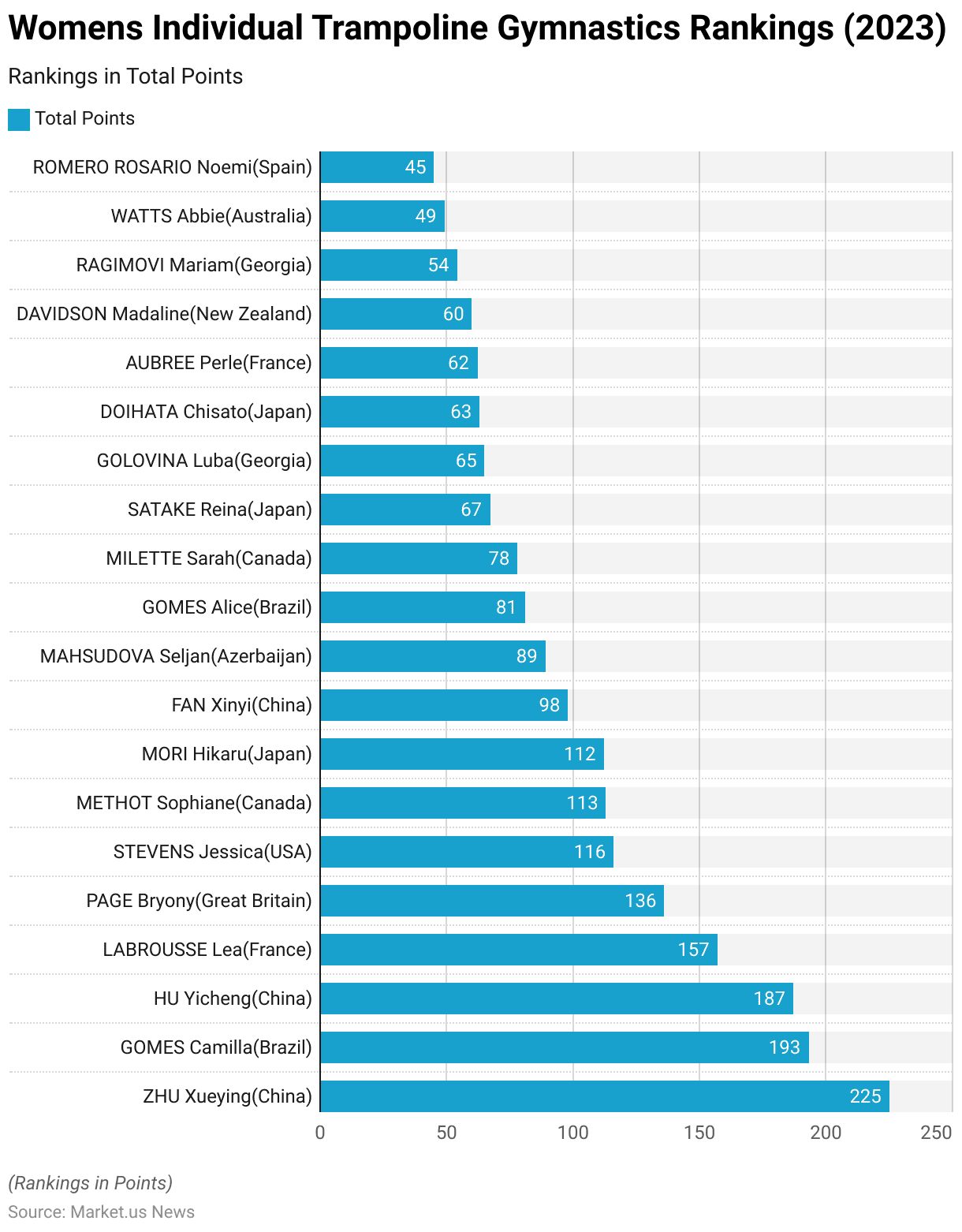
Mens Double-Mini
- The 2023 Men’s Double-Mini Trampoline Gymnastics Rankings feature a diverse lineup of athletes from around the globe.
- Gavin Dodd from Canada leads the rankings with 99 points.
- Following him is Tiago Sampaio Romão from Portugal with 88 points, and another Canadian, Nolan Zurek, in third place with 64 points.
- Santiago Ferrari from Argentina and Ruben Padilla from the USA are tied in fourth place, each with 60 points.
- Omo Aikeremiokha from Great Britain is next with 55 points, followed by Brent Deklerck from Belgium with 50 points.
- Diogo Cabral from Portugal ranks eighth with 45 points, and Artur Troyan from Ukraine is ninth with 44 points. Rounding out the top ten is Simon Smith from the USA, who scored 38 points.
- Other notable gymnasts include Zachary Blakely and Kieran Lupish from Canada, Bruno Oliveira from Portugal, Benjamin Brown from Australia, Gustav Tingeloef from Sweden, Ian Zermeno from Mexico, and Aaron Kusdemir from Belgium.
- Anthony Bianchet and Tomas Minc from Canada, along with Dylan Kline from the USA, also make the top twenty, demonstrating the competitive spirit and talent present in this year’s rankings.
(Source: Gymnastics)
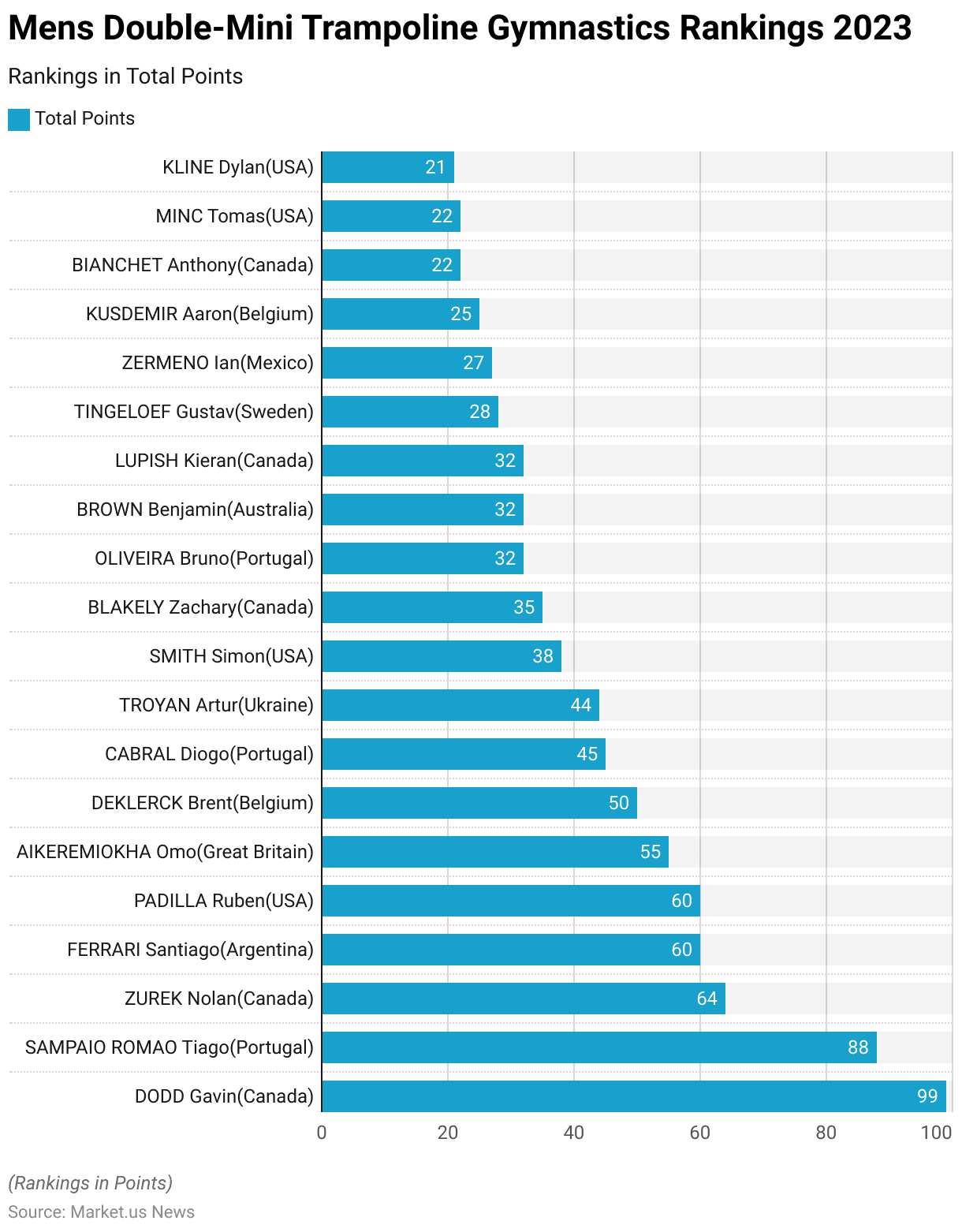
Womens Double-Mini
- The 2023 Women’s Double-Mini Trampoline Gymnastics Rankings are led by Australia’s Cheyanna Robinson, who tops the list with 105 points, closely followed by her fellow Australian Braida Thomas with 99 points.
- Canada’s Gabriella Flynn and Kirsty Way from Great Britain are tied for third, each amassing 60 points. Portugal’s Diana Gago ranks fifth with 53 points, slightly ahead of her compatriot Alexandra Garcia and New Zealand’s Melissa Romeril, who both scored 51 points.
- The top ten continues with Jacqueline Kent from the USA at 50 points, Hannah Brown from Canada at 44 points, and Amber French from Australia at 42 points.
- The list also includes Kayla Nel and Ruth Shevelan, both scoring 38 points, and Shelby Nobuhara of the USA with 32 points.
- Other notable gymnasts are Linn Bohlinde from Sweden with 28 points, Anastasia Heinrich from Germany with 25 points, and Aliah Raga from the USA with 22 points.
- Rounding out the top twenty are Ashley Anaka from Canada and Kim Beattie from Great Britain, each with 21 points, followed by Margarida Carreiro with 19 points and Matilde Nobre with 18 points, both from Portugal.
- This ranking highlights a strong international presence and competitive spirit among the athletes.
(Source: Gymnastics)
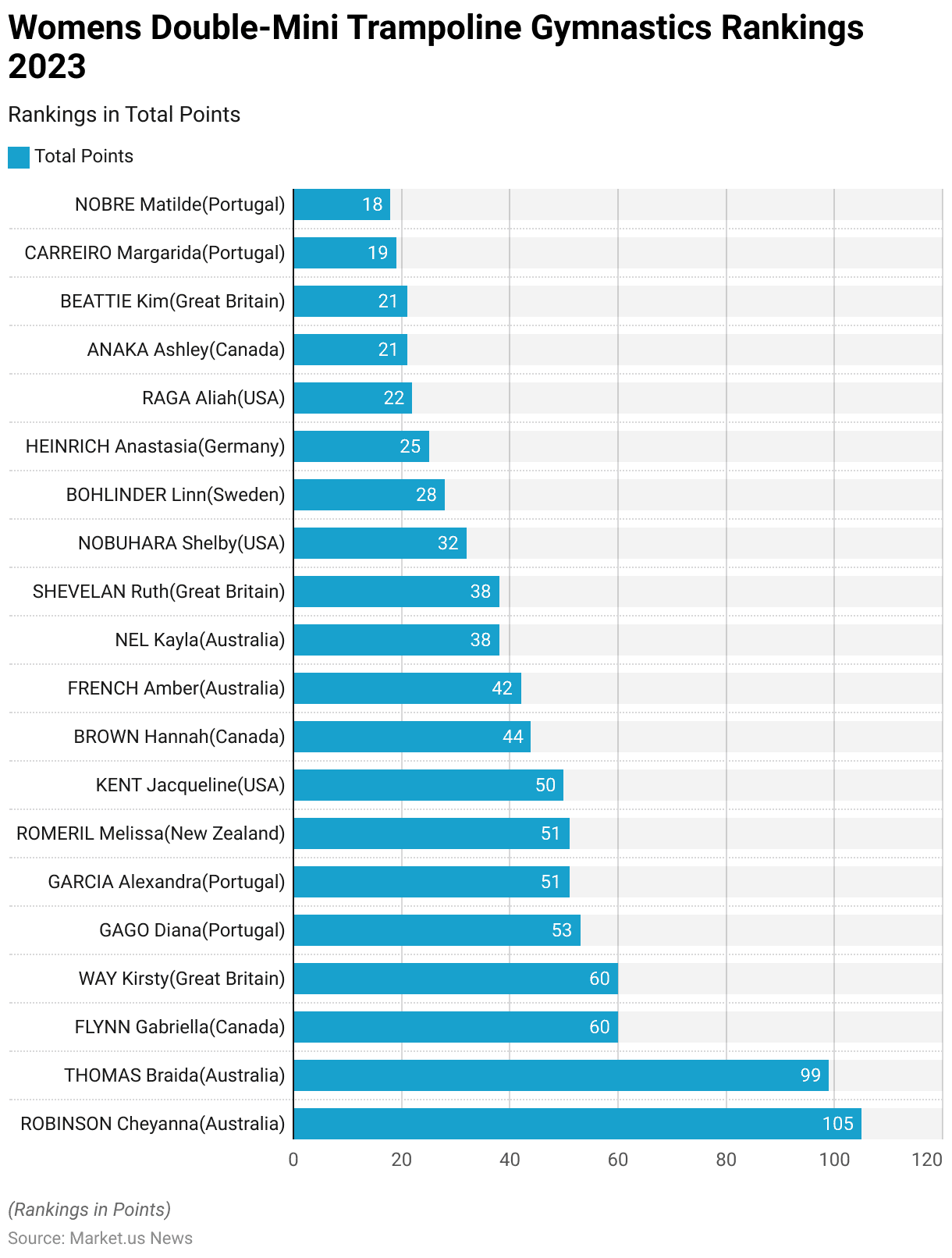
Demographics of Trampoline Participants Statistics
By Age Group
- During a three-month analysis from April to June 2019 across fifty trampoline parks, data revealed distinct patterns in the demographics of participants.
- The most common age for jumpers was found to be nine years old.
- Children aged 6 to 10 years comprised the largest segment, accounting for 35% of all jumpers.
- Adolescents between 11 to 15 years were the second largest group, making up 26% of participants.
- Notably, toddlers, ages 1 to 5, also participated significantly, contributing to 13% of the total jumps.
- Furthermore, adults in their 20s and 30s showed a growing interest in trampolining, representing 15% of all jumpers.
- This data illustrates a broad age range of individuals engaging in trampoline activities at these parks.
(Source: Roller)
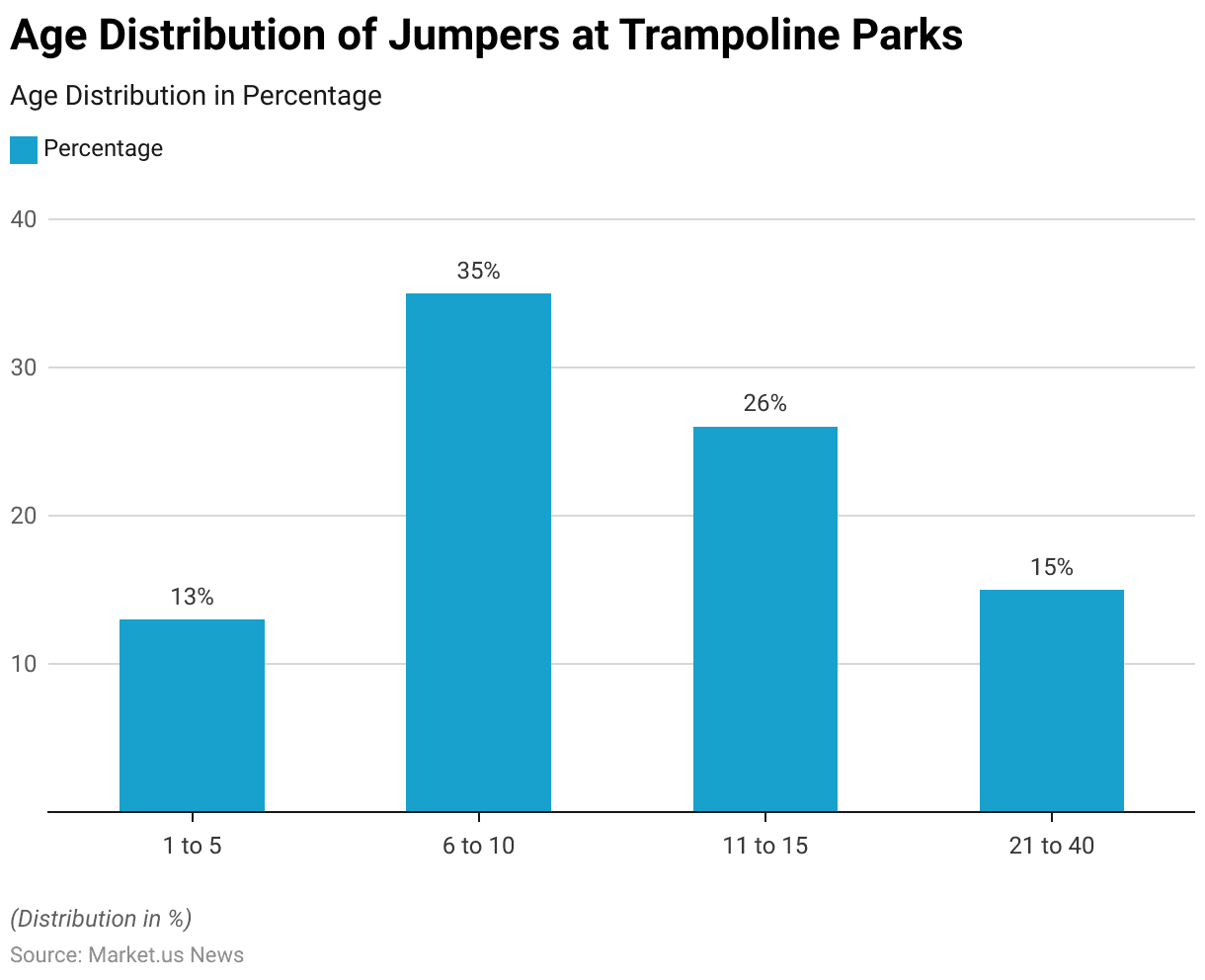
By Gender
- The data on active athletes across various gymnastics disciplines reveals a comprehensive breakdown by gender, age group, and total active participants.
- In Men’s Artistic Gymnastics, there are 1,177 senior men and 434 in age groups, totaling 1,611 active male participants.
- Women’s Artistic Gymnastics sees no senior men but has 1,117 senior women and 582 in age groups, with a total of 1,699 active female participants.
- Rhythmic Gymnastics is exclusive to women, featuring 1,201 senior women and 1,055 in age groups, totaling 2,256 active participants.
- Trampoline Gymnastics includes 738 senior men and 685 senior women, with 450 men and 598 women in age groups, leading to a combined total of 2,471 active participants.
- Acrobatic Gymnastics has 287 senior men and 558 senior women, with younger participants numbering 64 men and 290 women, culminating in 1,199 total active athletes.
- Aerobic Gymnastics shows 224 senior men and 502 senior women, with 146 men and 1,248 women in age groups, summing up to 2,120 active participants.
- Lastly, Parkour features 176 senior men and 51 senior women, totaling 227 active participants.
- Overall, the total number of active athletes across all disciplines amounts to 11,583, with a gender distribution of 2,602 men and 4,114 women in senior categories, as well as 1,094 men and 3,773 women in age groups.
(Source: International Federation of Gymnastics)
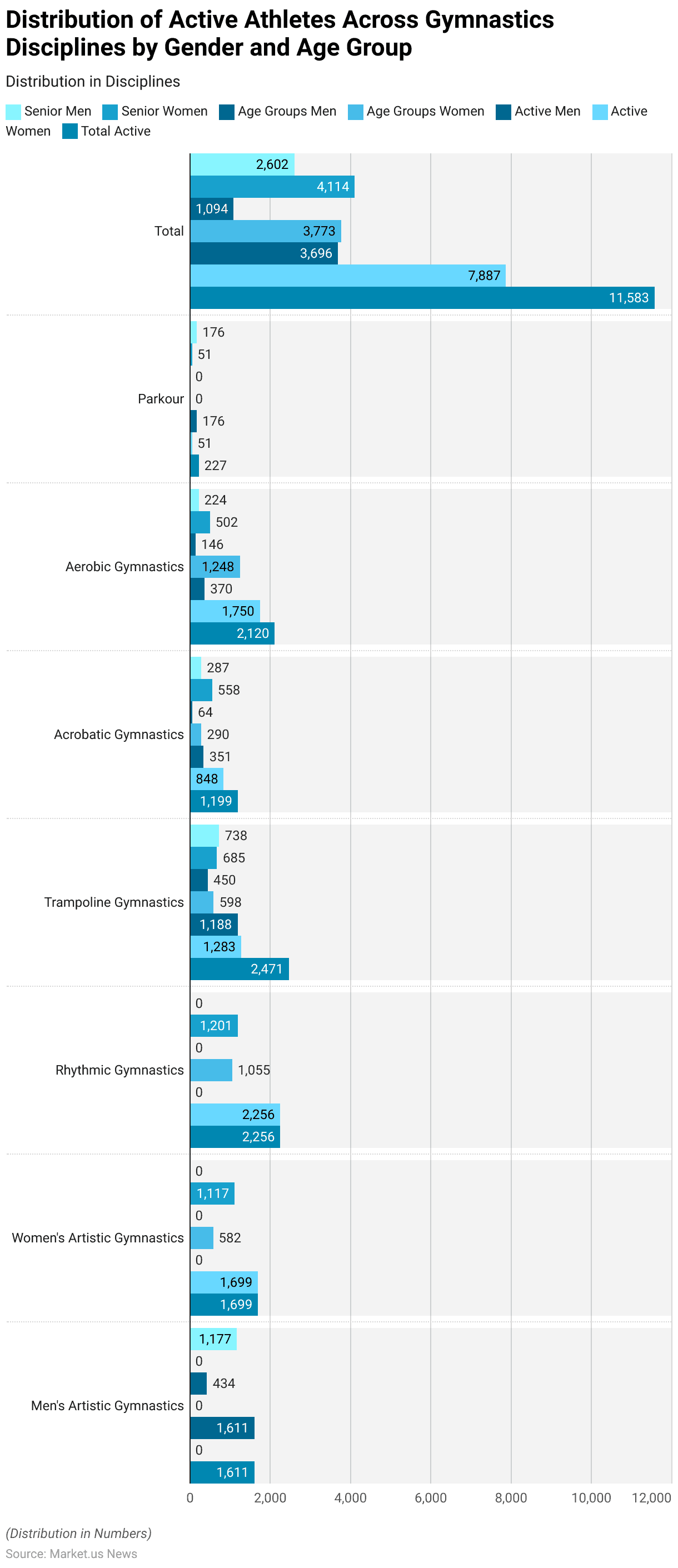
Demand for Indoor Trampolining
- The data reveals the proportion of respondents in Wales expressing an interest in initiating or increasing their participation in trampolining over three years from 2017 to 2019.
- In 2017, 2% of the respondents indicated a desire to start or engage more in trampolining.
- This figure rose to 3% in 2018, marking a slight increase in interest.
- However, in 2019, the share of respondents reverted to 2%, mirroring the initial level recorded in 2017.
- This fluctuation suggests a modest but not sustained growth in enthusiasm for trampolining within the survey population during these years.
(Source: Statista)
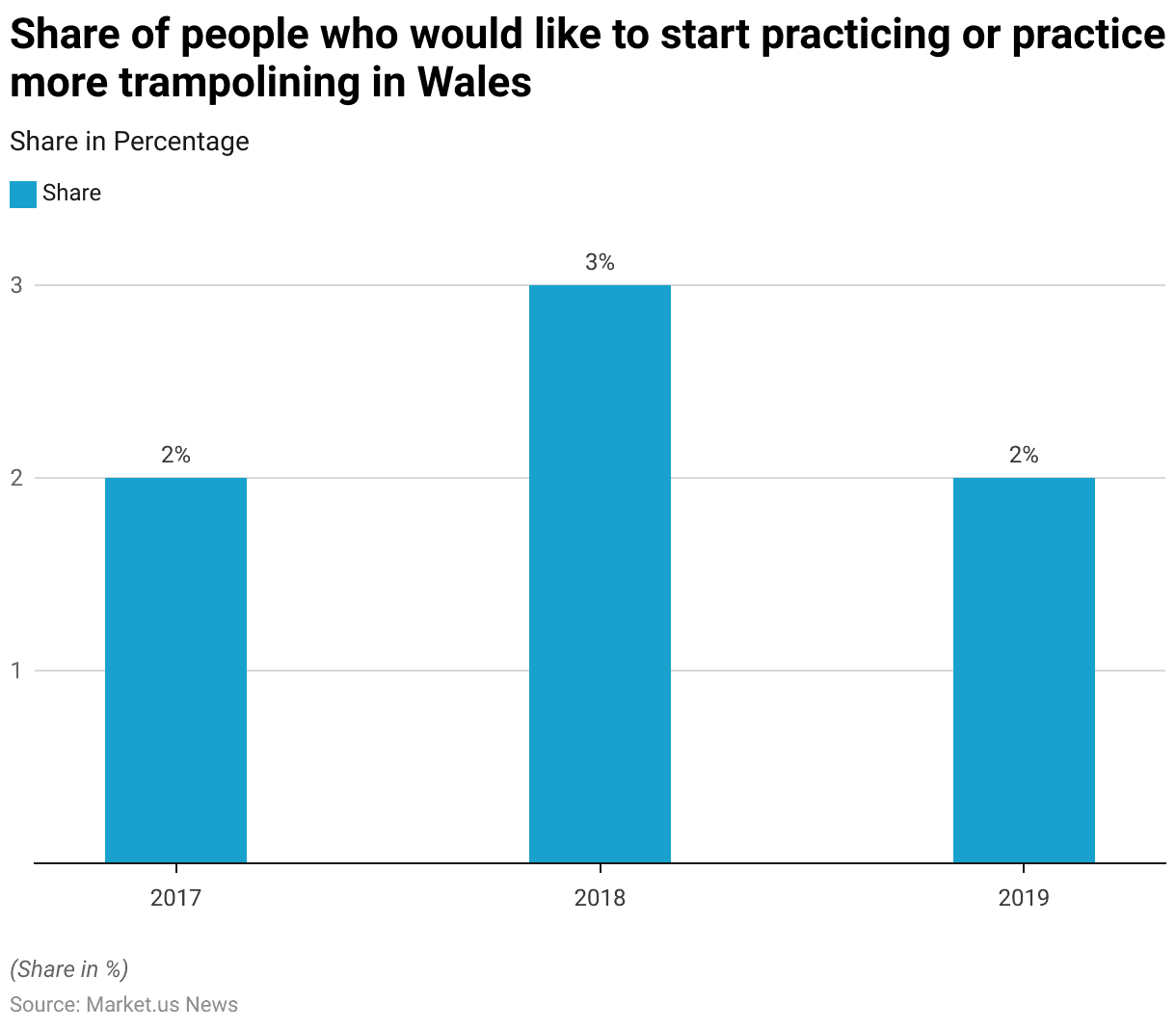
Trampoline Injuries Statistics
Types of Injuries
- Trampoline injuries include a variety of issues: 29% are fractures, and sprains and strains are also common, making up 27%.
- About 10-17% of injuries involve the head and neck, while 20% are bruises and contusions, and 5% are cuts.
- Ankle injuries are particularly common, representing 30% of all leg injuries from trampolines.
- In general, injuries to the arms and legs each make up 30% of all trampoline injuries, while soft tissue injuries, like bruises to muscles and tendons, account for 35%.
- Fractures to the arms alone account for 60% of all broken bones from trampolines. Head injuries lead to 10-15% of all trampoline-related emergency room visits.
- Meanwhile, leg injuries are 40% of all trampoline injuries. Spinal cord injuries are less common but still significant, representing 1-2% of injuries.
- Additionally, about 20% of all spinal cord injuries from sports and recreational activities are due to trampolines, and concussions account for 10% of trampoline injuries that need emergency care.
(Sources: National Library of Medicine, American Academy of Pediatrics, American Academy of Orthopaedic Surgeons)
Frequency and Prevalence
- Every year, nearly 100,000 trampoline injuries happen in the United States, leading to about 3,000 hospital stays.
- Between 2004 and 2014, these injuries saw a 140% increase, and they have risen by another 23% over the last decade.
- Trampoline injuries make up 3% of all sports injuries in children, and this percentage increases to 3.6% for children under 14.
- These injuries are more common during summer and result in around 500,000 emergency room visits globally each year.
- Out of all visits to the emergency room for injuries in children, one in every 200 is due to trampolines, and trampolines are the cause of one in every 1,000 hospital stays for children.
- The typical hospital visit for a trampoline injury lasts three days, costing about $800 per emergency department treatment.
- Overall, trampoline injuries cost about $1 billion in healthcare expenses annually in the US.
(Sources: National Library of Medicine, American Academy of Pediatrics, American Academy of Orthopaedic Surgeons)
Location of Injuries
- Most trampoline injuries, about 95%, happen at home, and half of these occur right on the mat where people jump.
- Another 27% of injuries happen when someone lands on the hard parts of the trampoline, like the springs or frame; this figure includes another statistic that 25% of injuries occur specifically on these parts.
- The majority of trampoline injuries, 80%, occur on large outdoor trampolines.
- For very young children under 5, 90% of their trampoline injuries also happen at home.
- Trampoline parks have seen a significant increase in injuries, with a 1500% rise from 2011 to 2017, and overall, 20% of trampoline injuries take place at public facilities or trampoline parks.
(Sources: National Library of Medicine, American Academy of Pediatrics, American Academy of Orthopaedic Surgeons)
Age-related Injuries
- Trampoline injuries are common among children, especially those under 14 years old.
- About 22% of these injuries happen to kids younger than 6 and in this age group. Half of the injuries lead to broken bones or dislocations.
- Children between 5 and 14 years old are the most likely to get hurt on trampolines, with those aged 5 to 9 experiencing the most bone breaks.
- Boys are slightly more prone to trampoline injuries than girls, with boys accounting for 52% of injuries.
- The average age of a child getting injured on a trampoline is nine years old, and very young children under six face a much higher risk, being 14 times more likely to get hurt compared to older kids.
- Children between 6 and 14 make up 67% of trampoline injuries, and overall. Kids under 10 years old suffer 75% of these injuries.
- The average age for severe injuries like damage to the spinal cord is 11 years.
(Sources: National Library of Medicine, American Academy of Pediatrics, American Academy of Orthopaedic Surgeons)
Risk Factors
- About 75% of trampoline injuries occur when multiple people are jumping at once, and the risk of injury increases by 75% in these situations.
- Children are two to three times more likely to get injured on trampolines at home compared to supervised training facilities.
- Performing somersaults and flips significantly raises the risk of neck injuries.
- Around 40% of injuries happen from falling off the trampoline, and 15% occur due to collisions between jumpers.
- Most injuries, around 60%, take place in the afternoon or early evening.
- Additionally, 35% of injuries are caused by attempts at stunts or flips, and 40% of accidents happen even under adult supervision.
(Sources: National Library of Medicine, American Academy of Pediatrics, American Academy of Orthopaedic Surgeons)
Prevention Measures
- Using safety nets around trampolines can cut the risk of injuries by 50% while adding padding to the frame and springs reduces the risk by 70%.
- Adult supervision can also lower the chance of injuries by 50%.
- For young children, using trampoline ladders can decrease the risk by 40%.
- Regularly inspecting and maintaining trampolines helps prevent injuries, reducing the risk by 30%.
- Wearing protective gear, like helmets and knee pads, can lower injury risk by 20%.
- Placing trampolines on level ground and away from structures can reduce the risk by 35%.
- Finally, limiting trampoline use to one person at a time can cut the risk of injuries by 75%.
(Sources: National Library of Medicine, American Academy of Pediatrics, American Academy of Orthopaedic Surgeons)
Trampoline Participation Regulations
- In the realm of trampoline gymnastics, the participation regulations and policies are meticulously outlined by governing bodies like the Fédération Internationale de Gymnastique (FIG) and national organizations such as USA Gymnastics.
- Each country adheres to the FIG’s detailed Code of Points and Technical Regulations, which define the scoring system, including difficulty, execution, and time of flight scores, and establish the framework for competitions ranging from local events to the Olympic Games.
- Additionally, specific regulations and policies cover everything from athlete eligibility and competition attire to anti-doping rules.
- In the United States, for instance, USA Gymnastics provides comprehensive access to its Rules & Policies book online. Ensuring updates and changes are disseminated promptly to the trampoline and tumbling community.
- This structured approach ensures uniformity and fairness in competition. Maintaining a standard that aligns with international guidelines and fosters the sport’s development globally.
(Sources: International Gymnastics Federation, USA Gymnastics)
Trampoline Initiatives Statistics
- Trampoline initiatives and programs are developing rapidly, driven by a demand for more interactive and safer recreational activities.
- Organizations like the US Tumbling and Trampoline Association (USTA) and the International Adventure & Trampoline Park Association (IATP) are at the forefront of these advancements.
- USTA has implemented a comprehensive Athlete Development Program (ADP) focusing on physical conditioning, mental preparation, and injury prevention alongside a Coach Education Program (CEP) that offers extensive training for coaches.
- This includes skill development, safety techniques, and rules of competition, enhancing both athlete and coach capabilities.
- Furthermore, the IATP advocates for industry standards and regulatory compliance to ensure safety and operational efficiency in trampoline parks.
- Their initiatives include educational programs, networking opportunities, and advocacy efforts aimed at legislative support for the industry.
- These programs are essential for maintaining safety and enhancing the guest experience, with measures like digital waivers to streamline operations and tiered membership programs to foster customer loyalty.
- These efforts collectively enhance the recreational experience, ensuring safety, engagement, and loyalty while also promoting continuous growth and innovation in the trampoline and adventure park industry.
(Source: Tramplinemind, Indoor Adventure Parks, Indoor Adventure Parks, ROLLER)
Recent Developments
Acquisitions and Mergers:
- Vuly Trampolines acquires Springfree Trampolines: In 2023, Vuly Trampolines, an Australian-based trampoline manufacturer, acquired Springfree Trampolines, a leading competitor known for its innovative spring-free designs, for $50 million. This acquisition aims to expand Vuly’s product range and global market share in the trampoline industry.
- Plum Products merges with Jumpking: In early 2024, Plum Products, a UK-based outdoor play equipment manufacturer, merged with Jumpking, a U.S. trampoline brand. The merger is valued at $80 million and is expected to strengthen both companies’ positions in the trampoline and outdoor play markets across Europe and North America.
New Product Launches:
- Skywalker Trampolines introduces Smart Trampoline with AI features: In 2023, Skywalker Trampolines launched a new Smart Trampoline with built-in AI technology. The trampoline comes equipped with sensors to track jumps, monitor safety, and provide real-time feedback through a mobile app, enhancing the safety and fun factor for users.
- Vuly introduces 360 Pro Trampoline: In mid-2023, Vuly Trampolines launched its 360 Pro Trampoline, featuring a fully enclosed design, integrated basketball hoop, and a rotating swing for added versatility. The 360 Pro targets both recreational and fitness enthusiasts, offering new play features and durability.
Funding:
- Springfree secures $25 million for innovation in safety features: In 2023, Springfree Trampolines raised $25 million in funding to develop new safety technologies. This investment will be used to integrate advanced materials and sensor technologies that further reduce injury risks for children and adults alike.
- Acon raises $15 million to expand production: In late 2023, Acon, a Finnish trampoline manufacturer, secured $15 million in funding to scale its production capacity and meet rising demand in Europe and North America. The funding will also be used to improve product durability and explore eco-friendly materials.
Technological Advancements:
- Smart trampolines with integrated sensors: By 2025, it is projected that 20% of trampolines will include smart features such as integrated sensors to monitor performance, track jumps, and ensure safety. These AI-driven enhancements are expected to make trampolines more interactive and safer.
- Eco-friendly trampoline materials: The trampoline industry is seeing a rise in the use of sustainable materials. By 2026, 30% of trampolines are expected to be made from eco-friendly or recyclable materials, as manufacturers move toward greener production practices.
Conclusion
Trampoline Statistics – The trampoline market has experienced notable growth, driven by increasing interest in recreational activities and fitness.
Advances in design and safety features, coupled with the rise of home-based fitness and outdoor recreation, have expanded its appeal.
Growth opportunities exist in both residential and commercial sectors, with trampoline parks and fitness centers highlighting product versatility.
However, safety regulations and injury concerns remain challenges. Overall, continued innovation and a focus on safety are expected to sustain market growth, driven by demand for engaging, fitness-oriented recreational products.
FAQs
Weight limits vary by model and manufacturer. Most trampolines designed for residential use have weight limits between 200 and 400 pounds. Always check the manufacturer’s specifications before purchasing or using the trampoline.
There are different trampoline shapes, including round, rectangular, and square. Round trampolines are the most common for recreational use, while gymnasts and athletes often prefer rectangular trampolines to provide a more consistent bounce across the surface. Square trampolines offer a mix of both.
Yes, safety enclosures are highly recommended. They help prevent falls and injuries by keeping jumpers inside the trampoline area. Many trampolines now come with built-in enclosures, and these are particularly important when children are using the trampoline.
Trampolines can be safe for children if proper precautions are followed, such as using a safety net, placing the trampoline on level ground, limiting the number of jumpers at one time, and ensuring adult supervision. Always adhere to the manufacturer’s safety guidelines.
The American Academy of Pediatrics recommends that trampolines should not be used by children under six years old. For older children, supervision is key, and safety rules should always be enforced.
Discuss Your Needs With Our Analyst
Please share your requirements with more details so our analyst can check if they can solve your problem(s)





